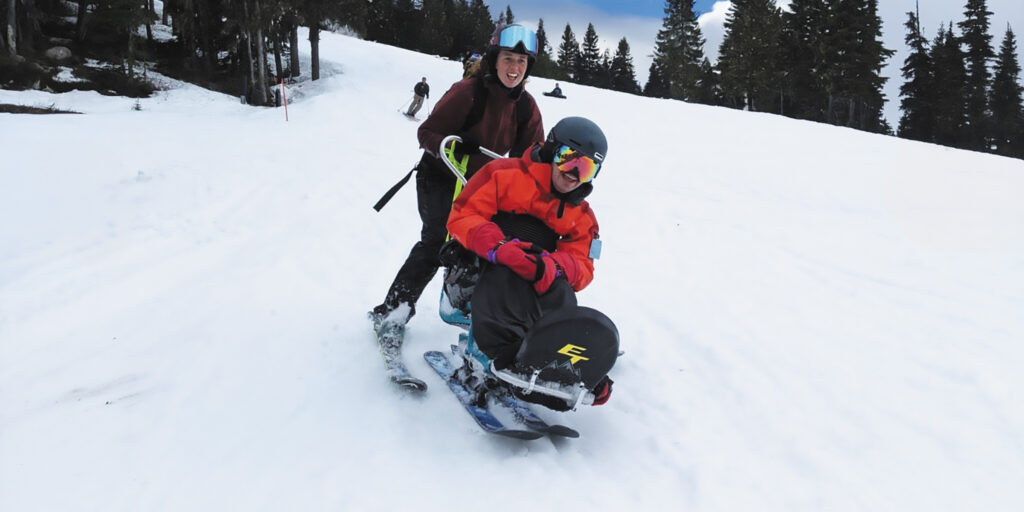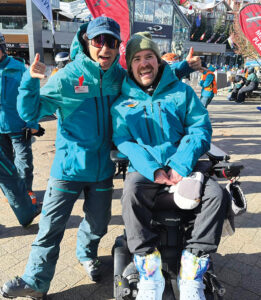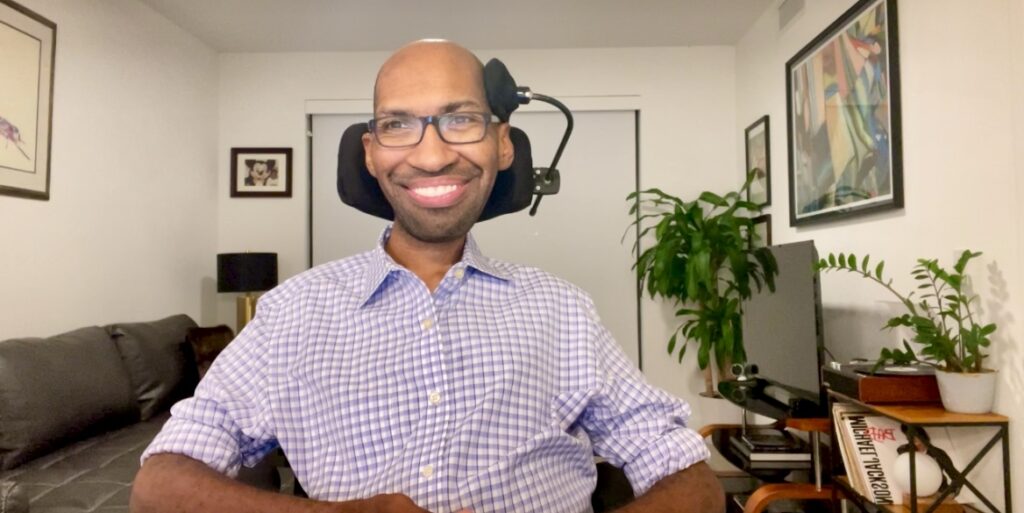
From the Ski Slopes to the Spirit of Inclusion
By Sean Marihugh | Friday, February 28, 2025
When I was learning to ski as a child in Washington state, like anyone new to the sport, I fell a lot and struggled with the equipment. I remember being afraid to point my skis downhill. But my strongest memory is the exhilarating feeling of freedom and independence as I glided down the mountain.
That began to change around the second grade, when I was diagnosed with Becker muscular dystrophy (BMD). By age 10, skiing was getting harder. My legs fatigued faster, walking in ski boots was draining, and I spent more time in the lodge than on the slopes.
Eventually, I decided I couldn’t ski anymore. It wasn’t the first time my diagnosis would challenge my sense of identity, but it was one of the most profound. I knew about adaptive ski programs that my brother volunteered with many years ago, but I never thought it was for me. Could I really do sports and be active?
Years later, in my 20s, I finally tried adaptive skiing with Seattle-based Outdoors for All. The familiarity of gliding down a mountain came rushing back, but in a new way that worked with my changing body. Adaptive skiing gave me back something I thought I’d lost: the freedom to move and connect with the mountains.
The importance of representation

Sean Marihugh enjoys being an adaptive ski instructor.
The phrase “nothing about us without us” is central to the disability rights movement, and it applies just as much to adaptive sports as it does to policy and advocacy.
I use a sit-ski consisting of a form-fitting seat on top of two skis. I typically ski with someone holding onto the back of my sit-ski — I’m controlling my turns and the path down the mountain but have support from a ski partner when I need it. Advancing to a level of competition is a common path for athletes, but because I don’t ski independently, it is closed off to me. I remember feeling discouraged after I began adaptive skiing, not sure what my path was or how I could continue developing in my sport.
Along the way, I realized that I rarely saw people “like me” as instructors or leaders in adaptive programs. The instructors I saw were skilled and passionate, but their lived experiences didn’t always align with those of the athletes they coached.
This is where I found my motivation to become an adaptive ski instructor. Even though I couldn’t ski competitively, I could be the mentor I wish I had all those years I didn’t ski — someone to show me that I do belong on the mountains.
When athletes see instructors who share their lived experiences, it’s easier for them to imagine what’s possible for them. It’s not just about teaching technique; it’s about showing people that they, too, can be athletes.
Connecting through experience
As an instructor with a disability, I can relate to athletes in unique ways — not only do I understand the mechanics, but I’ve been where they are. I’ve been anxious to try something new and learned to use my body in a way that felt foreign. I also know the joy of breaking through those feelings.
Each person’s body is different, and I love the creativity this inspires. Experimenting with new equipment and methods opens limitless possibilities to find what works. With BMD changing my body over time, I’m always in learning mode. Yes, it’s often scary and uncertain, but it’s rewarding to try something new and succeed at it.
Instructing has reminded me that the outdoors is for all of us — disability just means we experience it in unique ways. The best instructors, with and without disabilities, are the ones who want to understand you — how you learn, what motivates you, and the value of your lived experience with disability.
Building an inclusive future
Adaptive skiing gave me back something I thought I had lost, and becoming an instructor allows me to help others find that same freedom. But the work doesn’t stop there. The culture of these programs and the equipment available must evolve to include more voices and perspectives from the disability community.
That’s why I’m excited about the future of adaptive sports. Innovations like the TetraSki, a joystick-controlled sit-ski, are making skiing more accessible. These innovations can help people with neuromuscular diseases discover new ways to experience the mountains.
But inclusion isn’t just about tools; it’s about ensuring that the culture of adaptive sports reflects the community it serves. To bring more people to adaptive sports and the outdoors, we need more people “like us” to shape the direction, tell our unique stories, bring our creativity and passion, and demonstrate the joy of pushing our limits in new ways.
Representation isn’t just about individual moments; it’s about creating a culture of inclusion. When people with disabilities are in leadership roles, we create opportunities for others to see themselves as more than just participants.
When we say “nothing about us without us,” it’s not just a phrase — it’s the path to a more inclusive future.
Sean Marihugh, 32, has spent his career working in accessibility based on a fascination with how people with disabilities use technology. He is also a ski instructor, accessibility consultant, cat dad, and writer.
Next Steps and Useful Resources
- Recreation is for everybody. To find your activity, read our Guide to Getting Involved in Adaptive Sports.
- Stay up to date on Quest content! Subscribe to Quest Magazine and Newsletter.
TAGS: Featured Content, From Where I Sit, Staying Active
TYPE: Featured Article
Disclaimer: No content on this site should ever be used as a substitute for direct medical advice from your doctor or other qualified clinician.




